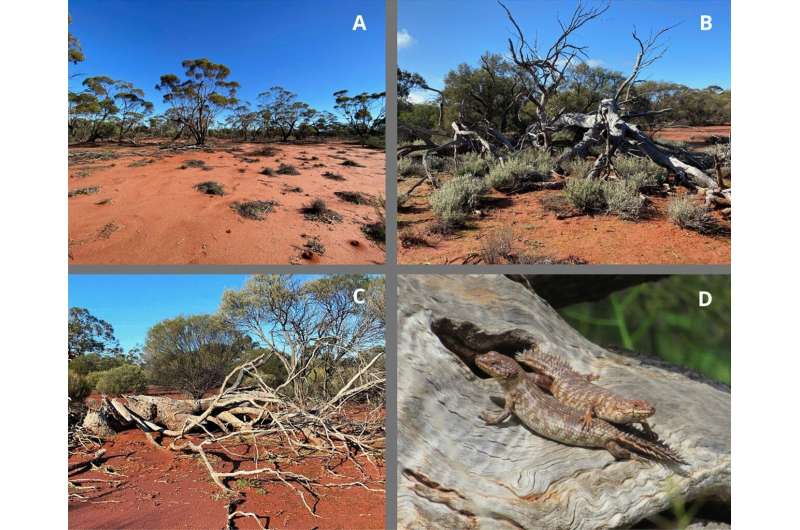Typical habitat of the skinks in the Mid West region of Western Australia; (A) open Eucalyptus woodland in which log piles were sparsely distributed; (B and C) examples of log piles inhabited by skink colonies; and (D) juvenile skinks basking by one of the hollows of an occupied log pile. Photos: H Bradley. Credit: Scientific Reports (2022). DOI: 10.1038/s41598-022-08524-2
Wooden "castles" that house families of endangered Western Spiny-tailed Skinks attract feral and native predators, as Curtin researchers use light-detection technology to re-create their habitat in a potential game-changer for global animal conservation.
Researchers used light detection and ranging (LiDAR) technology—commonly used in mine sites—to create high-resolution scans of numerous log "castles" to identify exactly what the lizards liked about particular log "castles," in order to replicate them and help with future habitat restoration.
Lead researcher Ph.D. student Holly Bradley from Curtin's School of Molecular and Life Sciences said this study showed that LiDAR was an accurate, effective tool that could be applied world-wide to help with animal conservation efforts.
"The Western Spiny-tailed Skink is an unusual reptile as it has a large spiny tail for defense and they live together in family groups in wooden 'castles' made up of the remains of fallen trees, but they don't seem to like all 'castles' and only live in some," Bradley said.
"LiDAR is a device that uses lasers to create a highly accurate 3D model and is most commonly attached to small planes or drones for the mining industry to map landform structures.
"This is the first time that LiDAR technology has been used in this way—to help characterize the microhabitat requirements of a particular threatened species. This will help us to identify areas and habitat structures that are important for protection, as well as showing us how to recreate the optimal wooden 'castles' during landscape restoration to help safeguard the future for the Western Spiny-tailed Skink."
Research supervisor Associate Professor Bill Bateman said these skinks live in the arid Mid West of Western Australia, a region that presents numerous threats, including active mining operations.
"We identified that crows and ravens target these log castles and even though they are native birds, they can become very abundant around mining landfill sites," Bateman said. "The skinks are also susceptible to harm from feral cats who hunt baby and adult skinks.
"For the ongoing survival of the endangered Western Spiny-tailed Skink, introduced predators must be managed and resources such as landfill sites around mining operations need to be managed to prevent native predators becoming too frequent."
More information: Holly S. Bradley et al, Predators in a mining landscape: Threats to a behaviourally unique, endangered lizard, Austral Ecology (2022). DOI: 10.1111/aec.13195
Holly S. Bradley et al, Revealing microhabitat requirements of an endangered specialist lizard with LiDAR, Scientific Reports (2022). DOI: 10.1038/s41598-022-08524-2
Journal information: Scientific Reports
Provided by Curtin University
























